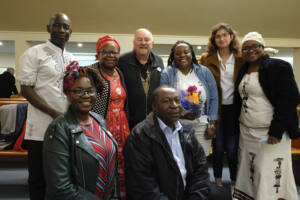
WelCom February 2023
Results of the Archdiocese of Wellington’s two-year review of its ethnic communities, released late last year, indicate that the Catholic community’s multicultural population is continuing to grow and develop.
‘This raises significant pastoral issues,’ says Maya Bernardo, the Archdiocese’s Launch Out Programme Formator and Manager. ‘The review was a response to the recommendation from the 2017 Synod,’ she said.
The two-year review, hampered by Covid and lockdowns, was conducted under the Office of the Vicar General, Mons Gerard Burns. It targeted Catholic migrants and ethnicities, apart from European and Māori.
The review sourced government demographic data from a survey and included interviews and discussions.
Results show the archdiocese’s parishes are diverse and growing in diversity. About 25–30% of parishioners is neither Māori nor Pākehā; 76% of migrant Catholics are under 60; 85% feel actively involved in their parishes; 69% were born overseas; 90% live with families; and most young Catholics are from migrant families.
The review heard immigrant Catholics have different theological perspectives and views of Church history.
‘My understanding of the Church, as I now experience in the Archdiocese of Wellington, is synodal by nature. How then do we bring people together?’ Maya Bernado asks.
Immigrant families tend to live differently, too. Bernardo says the 90% of Catholic migrants who live with family is significant. The way they live suggests their faith life is shared and expressed as a collective. It’s different from the individualistic western-world view.
Knowing who immigrants live with can guide us in the way we encourage and facilitate participation, Bernardo says.
The review found many young people are moving to other Christian churches or the secular world within families; they find it hard to connect and be nourished by the liturgies and feel left out in the ministries.
What does it say about the future of our parishes, their effectiveness in reaching out to the young and what it is that keeps the young away?
asks Bernardo.
The way parishes prepare migrant communities for parish and diocesan leadership is important. The review also raises a question about how parish pastoral councils reflect the diversity in church pews.
‘Encouraging participation is not a one-strategy; one-size-fits-all. It also means challenging behaviours that denigrate someone’s race and including migrant voices in shaping the parish. How can we encourage participation and grow leadership among the migrant communities? What can we do to understand each other better?’
Migrants straddle different worlds, Bernardo says. ‘New Zealand does not understand our suffering,’ some participants told the review.
They reported feeling misunderstood, lonely and disconnected from the mainstream Catholic community. Language barriers can be a big issue. Translation can be difficult.
Parishes need to consider ways to grow as a community aware of each other’s presence and those still on the peripheries.
More is not necessarily ‘the merrier’ but could be ‘the messier’. This is the way the Church has always been: intrinsically diverse.
Finding a way through review statistics and commentaries is not easy, Bernardo says.
‘The review only reveals an unfinished business, leaving perhaps more questions than answers…[but it] hopefully helps us ask better questions.’
Please email: m.bernardo@wn.catholic.org.nz if you would like a copy of the review.
Sources: Launch Out Letters; CathNews NZ